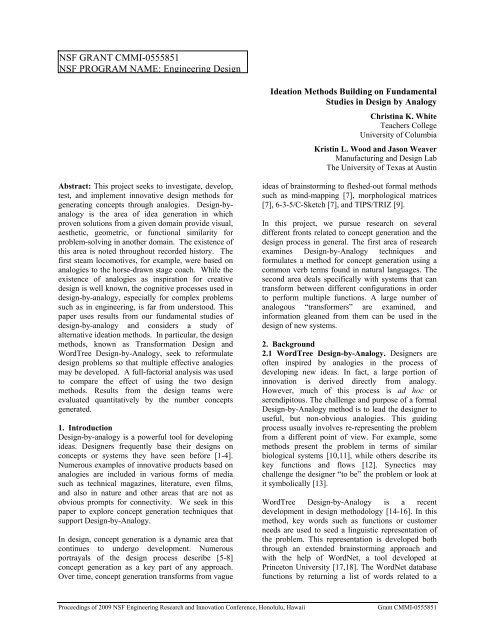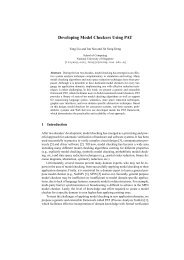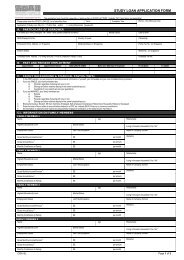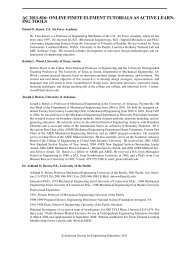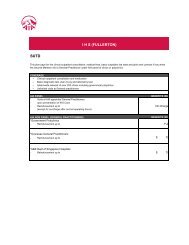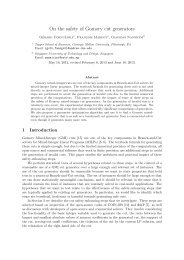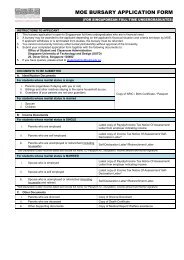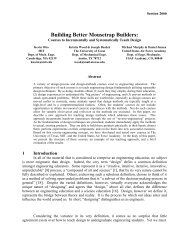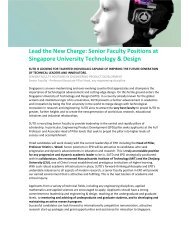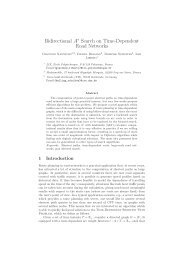Ideation Methods Building on Fundamental Studies in Design by ...
Ideation Methods Building on Fundamental Studies in Design by ...
Ideation Methods Building on Fundamental Studies in Design by ...
Create successful ePaper yourself
Turn your PDF publications into a flip-book with our unique Google optimized e-Paper software.
NSF GRANT CMMI-0555851NSF PROGRAM NAME: Eng<strong>in</strong>eer<strong>in</strong>g <strong>Design</strong><str<strong>on</strong>g>Ideati<strong>on</strong></str<strong>on</strong>g> <str<strong>on</strong>g>Methods</str<strong>on</strong>g> <str<strong>on</strong>g>Build<strong>in</strong>g</str<strong>on</strong>g> <strong>on</strong> <strong>Fundamental</strong><strong>Studies</strong> <strong>in</strong> <strong>Design</strong> <strong>by</strong> AnalogyChrist<strong>in</strong>a K. WhiteTeachers CollegeUniversity of ColumbiaKrist<strong>in</strong> L. Wood and Jas<strong>on</strong> WeaverManufactur<strong>in</strong>g and <strong>Design</strong> LabThe University of Texas at Aust<strong>in</strong>Abstract: This project seeks to <strong>in</strong>vestigate, develop,test, and implement <strong>in</strong>novative design methods forgenerat<strong>in</strong>g c<strong>on</strong>cepts through analogies. <strong>Design</strong>-<strong>by</strong>analogyis the area of idea generati<strong>on</strong> <strong>in</strong> whichproven soluti<strong>on</strong>s from a given doma<strong>in</strong> provide visual,aesthetic, geometric, or functi<strong>on</strong>al similarity forproblem-solv<strong>in</strong>g <strong>in</strong> another doma<strong>in</strong>. The existence ofthis area is noted throughout recorded history. Thefirst steam locomotives, for example, were based <strong>on</strong>analogies to the horse-drawn stage coach. While theexistence of analogies as <strong>in</strong>spirati<strong>on</strong> for creativedesign is well known, the cognitive processes used <strong>in</strong>design-<strong>by</strong>-analogy, especially for complex problemssuch as <strong>in</strong> eng<strong>in</strong>eer<strong>in</strong>g, is far from understood. Thispaper uses results from our fundamental studies ofdesign-<strong>by</strong>-analogy and c<strong>on</strong>siders a study ofalternative ideati<strong>on</strong> methods. In particular, the designmethods, known as Transformati<strong>on</strong> <strong>Design</strong> andWordTree <strong>Design</strong>-<strong>by</strong>-Analogy, seek to reformulatedesign problems so that multiple effective analogiesmay be developed. A full-factorial analysis was usedto compare the effect of us<strong>in</strong>g the two designmethods. Results from the design teams wereevaluated quantitatively <strong>by</strong> the number c<strong>on</strong>ceptsgenerated.1. Introducti<strong>on</strong><strong>Design</strong>-<strong>by</strong>-analogy is a powerful tool for develop<strong>in</strong>gideas. <strong>Design</strong>ers frequently base their designs <strong>on</strong>c<strong>on</strong>cepts or systems they have seen before [1-4].Numerous examples of <strong>in</strong>novative products based <strong>on</strong>analogies are <strong>in</strong>cluded <strong>in</strong> various forms of mediasuch as technical magaz<strong>in</strong>es, literature, even films,and also <strong>in</strong> nature and other areas that are not asobvious prompts for c<strong>on</strong>nectivity. We seek <strong>in</strong> thispaper to explore c<strong>on</strong>cept generati<strong>on</strong> techniques thatsupport <strong>Design</strong>-<strong>by</strong>-Analogy.In design, c<strong>on</strong>cept generati<strong>on</strong> is a dynamic area thatc<strong>on</strong>t<strong>in</strong>ues to undergo development. Numerousportrayals of the design process describe [5-8]c<strong>on</strong>cept generati<strong>on</strong> as a key part of any approach.Over time, c<strong>on</strong>cept generati<strong>on</strong> transforms from vagueideas of bra<strong>in</strong>storm<strong>in</strong>g to fleshed-out formal methodssuch as m<strong>in</strong>d-mapp<strong>in</strong>g [7], morphological matrices[7], 6-3-5/C-Sketch [7], and TIPS/TRIZ [9].In this project, we pursue research <strong>on</strong> severaldifferent fr<strong>on</strong>ts related to c<strong>on</strong>cept generati<strong>on</strong> and thedesign process <strong>in</strong> general. The first area of researchexam<strong>in</strong>es <strong>Design</strong>-<strong>by</strong>-Analogy techniques andformulates a method for c<strong>on</strong>cept generati<strong>on</strong> us<strong>in</strong>g acomm<strong>on</strong> verb terms found <strong>in</strong> natural languages. Thesec<strong>on</strong>d area deals specifically with systems that cantransform between different c<strong>on</strong>figurati<strong>on</strong>s <strong>in</strong> orderto perform multiple functi<strong>on</strong>s. A large number ofanalogous “transformers” are exam<strong>in</strong>ed, and<strong>in</strong>formati<strong>on</strong> gleaned from them can be used <strong>in</strong> thedesign of new systems.2. Background2.1 WordTree <strong>Design</strong>-<strong>by</strong>-Analogy. <strong>Design</strong>ers areoften <strong>in</strong>spired <strong>by</strong> analogies <strong>in</strong> the process ofdevelop<strong>in</strong>g new ideas. In fact, a large porti<strong>on</strong> of<strong>in</strong>novati<strong>on</strong> is derived directly from analogy.However, much of this process is ad hoc orserendipitous. The challenge and purpose of a formal<strong>Design</strong>-<strong>by</strong>-Analogy method is to lead the designer touseful, but n<strong>on</strong>-obvious analogies. This guid<strong>in</strong>gprocess usually <strong>in</strong>volves re-represent<strong>in</strong>g the problemfrom a different po<strong>in</strong>t of view. For example, somemethods present the problem <strong>in</strong> terms of similarbiological systems [10,11], while others describe itskey functi<strong>on</strong>s and flows [12]. Synectics maychallenge the designer “to be” the problem or look atit symbolically [13].WordTree <strong>Design</strong>-<strong>by</strong>-Analogy is a recentdevelopment <strong>in</strong> design methodology [14-16]. In thismethod, key words such as functi<strong>on</strong>s or customerneeds are used to seed a l<strong>in</strong>guistic representati<strong>on</strong> ofthe problem. This representati<strong>on</strong> is developed boththrough an extended bra<strong>in</strong>storm<strong>in</strong>g approach andwith the help of WordNet, a tool developed atPr<strong>in</strong>cet<strong>on</strong> University [17,18]. The WordNet databasefuncti<strong>on</strong>s <strong>by</strong> return<strong>in</strong>g a list of words related to aProceed<strong>in</strong>gs of 2009 NSF Eng<strong>in</strong>eer<strong>in</strong>g Research and Innovati<strong>on</strong> C<strong>on</strong>ference, H<strong>on</strong>olulu, HawaiiGrant CMMI-0555851
Figure 1: Exemplar WordNet results andWordTree for key word “track” [17].user-supplied seed word. WordNet works similarly toa thesaurus, but gives much more functi<strong>on</strong>ality andstructure. For each <strong>in</strong>put word, WordNet returns a setof trop<strong>on</strong>yms (sub-types or more specific syn<strong>on</strong>yms),hypernyms (overarch<strong>in</strong>g or more general syn<strong>on</strong>yms),and sister terms (other words stemm<strong>in</strong>g from acomm<strong>on</strong> hypernym). An example WordNet entry forthe verb “track” is shown <strong>in</strong> Fig. 1. The <strong>in</strong>formati<strong>on</strong>retrieved from WordNet can easily be assembled <strong>in</strong>toa graphical representati<strong>on</strong> called a WordTree, withhypernyms and trop<strong>on</strong>yms branch<strong>in</strong>g off of the seedterm like roots and branches. An example WordTreebased off of the same key word “track” is shown <strong>in</strong>Fig. 1.Hence the name, the <strong>in</strong>formati<strong>on</strong> <strong>in</strong> a WordTree canbe used to branch out from known functi<strong>on</strong>s andcustomer needs <strong>in</strong>to far-field applicati<strong>on</strong>s. Forexample, a sample design problem may require thefuncti<strong>on</strong> “track,” as <strong>in</strong> Fig. 1. The associatedWordTree terms may lead the designer to explorecurrent applicati<strong>on</strong>s of “hunt” (perhaps hunt<strong>in</strong>g for asoluti<strong>on</strong> to a problem or hunt<strong>in</strong>g for a lost item). Itwould also lead to ways to “scout” or “rec<strong>on</strong>noiter”(methods and skills used <strong>by</strong> explorersor pi<strong>on</strong>eers),and tools to “m<strong>on</strong>itor” or “trace” (to view thesituati<strong>on</strong> from different vantage po<strong>in</strong>ts – perhapsthrough electr<strong>on</strong>ics). These tra<strong>in</strong>s of thought wouldreveal specific, real-world examples that might haveotherwise g<strong>on</strong>e unnoticed. By explor<strong>in</strong>g multipleWordTrees, the designer is led towards a wide swathof related c<strong>on</strong>cepts and applicati<strong>on</strong>s far-removedfrom the <strong>in</strong>itial problem, i.e., design-<strong>by</strong>-analogy.Figure 2 shows a more extensive and complete formof the WordTree <strong>Design</strong>-<strong>by</strong>-Analogy method. Noticethat the method provides scaffold<strong>in</strong>g <strong>by</strong>systematically guid<strong>in</strong>g a designer or design teamthrough the explorati<strong>on</strong> of analogous verb terms andanalogous doma<strong>in</strong>s. An exemplar design result is alsoshown, provid<strong>in</strong>g design c<strong>on</strong>cepts for the problem ofassist<strong>in</strong>g pers<strong>on</strong>s with disabilities <strong>in</strong> fold<strong>in</strong>g clothesas part of their daily jobs.2.2. Transformati<strong>on</strong> <strong>Design</strong>. Transformati<strong>on</strong>, <strong>in</strong> amechanical sense, can be def<strong>in</strong>ed as chang<strong>in</strong>g state(or c<strong>on</strong>figurati<strong>on</strong>) <strong>in</strong> order to provide newfuncti<strong>on</strong>ality [19,20,21]. Transform<strong>in</strong>g, orrec<strong>on</strong>figurable systems occur frequently <strong>in</strong> design,rang<strong>in</strong>g from vehicles to furniture to toys and tools.From the comics to toy chests to the movie screen,the pr<strong>in</strong>ciples and facilitators of transformati<strong>on</strong> tapthe imag<strong>in</strong>ati<strong>on</strong> of many who may not have <strong>in</strong>itiallybeen <strong>in</strong>trigued <strong>by</strong> and been exposed to the eleganteng<strong>in</strong>eer<strong>in</strong>g c<strong>on</strong>cepts. This 20 th century a pop culturephenomen<strong>on</strong> of Transformers is a scaffold<strong>in</strong>g toolthat potentially c<strong>on</strong>nects to teach<strong>in</strong>g and learn<strong>in</strong>g 21 stcentury eng<strong>in</strong>eer<strong>in</strong>g.A basic example of a transformer is shown <strong>in</strong> Fig. 3.Here, a chair transforms <strong>in</strong>to a stepstool <strong>by</strong> fold<strong>in</strong>ghalf of the structure about a h<strong>in</strong>ge.Figure 2: Complete WordTree <strong>Design</strong>-<strong>by</strong>-AnalogyMethodology and Exemplar Result [16,17].Proceed<strong>in</strong>gs of 2009 NSF Eng<strong>in</strong>eer<strong>in</strong>g Research and Innovati<strong>on</strong> C<strong>on</strong>ference, H<strong>on</strong>olulu, HawaiiGrant CMMI-0555851
Table 1: Transformati<strong>on</strong> pr<strong>in</strong>ciples and facilitators [20].Expand/CollapsePr<strong>in</strong>ciplesExpose/CoverFuse/DivideC<strong>on</strong>formwithStructuralInterface[23]FlipInterchangeWork<strong>in</strong>g OrganEnclose Furcate ModularizeFacilitators[22]Roll/Wrap/CoilShare CoreStructureShare PowerTransmissi<strong>on</strong>ShellFan Inflate Nest Share Functi<strong>on</strong>s Telescope[24]UtilizeCompositesUtilizeGenericC<strong>on</strong>necti<strong>on</strong>sfreedom to pursue unc<strong>on</strong>venti<strong>on</strong>al match-ups am<strong>on</strong>gthe pr<strong>in</strong>ciples and facilitators.Figure 3: Transform<strong>in</strong>g chair/stepstool [22].Transformers can be complex and difficult toexecute, yet their historic design has been mostly adhoc, rely<strong>in</strong>g <strong>on</strong> serendipitous analogies and previousexperience to create smooth, functi<strong>on</strong>altransformati<strong>on</strong> processes. Over the past three years,extensive research has been c<strong>on</strong>ducted to betterunderstand how transformati<strong>on</strong> works, how it iscurrently designed, and how a better, moreformalized design process could be applied. Over thecourse of this research, a theory of transformati<strong>on</strong>design has been developed which identifies a set ofpr<strong>in</strong>ciples and facilitators relevant to the process oftransformati<strong>on</strong> (Table 1). These pr<strong>in</strong>ciples andfacilitators represent meta-analogies to generatec<strong>on</strong>cepts for design problems.Additi<strong>on</strong>al research shows that these pr<strong>in</strong>ciples andfacilitators occur <strong>in</strong> c<strong>on</strong>sistent, predictable patterns[20,21]. These trends and <strong>in</strong>terrelati<strong>on</strong>ships can beutilized to assemble transformati<strong>on</strong> processes thatoperate smoothly and robustly, while still hav<strong>in</strong>g the3. Research ExperimentA c<strong>on</strong>trolled experiment was designed with the aimof compar<strong>in</strong>g the effect of us<strong>in</strong>g WordTrees and/orTransformati<strong>on</strong> <strong>Design</strong> methods <strong>in</strong> the c<strong>on</strong>ceptgenerati<strong>on</strong> process. To focus <strong>on</strong> these two methods,other parts of the process were c<strong>on</strong>trolled as much aspossible.<strong>Design</strong> teams of three to six members generatedc<strong>on</strong>cepts for a design problem; specifically to create asystem that can tag and track a vehicle for emergencypurposes, then perform an effect <strong>on</strong> the target whendesired, <strong>in</strong> this scenario, to aid the search and rescueteam <strong>in</strong> events to help with hostage situati<strong>on</strong>s. Anillustrati<strong>on</strong> of this scenario is shown <strong>in</strong> Fig. 4. Teammembers followed a script outl<strong>in</strong><strong>in</strong>g the methods tobe used and recorded all c<strong>on</strong>cepts for subsequentanalysis.3.1 Source of Participants. Forty-<strong>on</strong>e participantswere assembled <strong>in</strong>to n<strong>in</strong>e teams of three to six peoplefor this study. All participants were volunteerundergraduate students at The University of Texas atAust<strong>in</strong>. Approximately 75% of them were male, 25%were female. The volunteers’ ages ranged from 21-27. At the time of the study, they were enrolled <strong>in</strong> asenior-level mechanical eng<strong>in</strong>eer<strong>in</strong>g capst<strong>on</strong>e designclass, where they had previously learned comm<strong>on</strong>c<strong>on</strong>cept generati<strong>on</strong> techniques such as m<strong>in</strong>d-mapp<strong>in</strong>gProceed<strong>in</strong>gs of 2009 NSF Eng<strong>in</strong>eer<strong>in</strong>g Research and Innovati<strong>on</strong> C<strong>on</strong>ference, H<strong>on</strong>olulu, HawaiiGrant CMMI-0555851
and 6-3-5. The volunteers had experience typical ofundergraduate eng<strong>in</strong>eer<strong>in</strong>g students, with somereceiv<strong>in</strong>g additi<strong>on</strong>al tra<strong>in</strong><strong>in</strong>g through <strong>in</strong>ternships, coops,previous jobs, and research opportunities.Because of their general eng<strong>in</strong>eer<strong>in</strong>g experience andcomm<strong>on</strong> level of understand<strong>in</strong>g of design as taught <strong>in</strong>the class, it was assumed that they would havecomparable backgrounds com<strong>in</strong>g <strong>in</strong>to the test study.Figure 4: Example scenario <strong>in</strong>volv<strong>in</strong>g "tag, track, and effect" design problem.3.2 Factorial Organizati<strong>on</strong>. The study wasformulated as a basic 2 2 factorial experiment withfour different c<strong>on</strong>diti<strong>on</strong>s. The two c<strong>on</strong>trolledvariables were the use of the WordTree <strong>Design</strong>-<strong>by</strong>-Analogy method and the use of the Transformati<strong>on</strong><strong>Design</strong> method.In the first trial (- -), neither WordTrees nortransformati<strong>on</strong> heuristics were used. This c<strong>on</strong>diti<strong>on</strong>corresp<strong>on</strong>ds to a c<strong>on</strong>trol. After a brief <strong>in</strong>troducti<strong>on</strong>, adesign problem was given, after which theparticipants spent 25 m<strong>in</strong>utes bra<strong>in</strong>storm<strong>in</strong>g with am<strong>in</strong>d-map. This was followed <strong>by</strong> 30 m<strong>in</strong>utes of 6-3-5. In the f<strong>in</strong>al stage of the process, each participantsearched the Internet (through patents, images,videos, and design websites) for additi<strong>on</strong>al<strong>in</strong>formati<strong>on</strong> <strong>on</strong> analogies uncovered dur<strong>in</strong>g the earlierstages. A research assistant <strong>in</strong>troduced each step ofthe process, us<strong>in</strong>g a script for c<strong>on</strong>sistency <strong>in</strong> languageand tim<strong>in</strong>g. The complete outl<strong>in</strong>e for this “c<strong>on</strong>trol”variati<strong>on</strong> is given <strong>in</strong> the next secti<strong>on</strong>.In the sec<strong>on</strong>d trial (+ -), a WordTree <strong>Design</strong>-<strong>by</strong>-Analogy method was <strong>in</strong>serted before the m<strong>in</strong>dmapp<strong>in</strong>g.This method is also outl<strong>in</strong>ed <strong>in</strong> the nextsecti<strong>on</strong>. The third trial (- +) <strong>in</strong>serted an <strong>in</strong>troducti<strong>on</strong>to transformati<strong>on</strong> pr<strong>in</strong>ciples and facilitators, with<strong>in</strong>formati<strong>on</strong> <strong>on</strong> how to use them. The fourth trial (++) used both WordTrees and transformati<strong>on</strong>heuristics3.3 Outl<strong>in</strong>e of Experiment. Each <strong>in</strong>stance of theexperiment followed the outl<strong>in</strong>e shown below. Thec<strong>on</strong>trol (- -) trial follows the steps as listed, exclud<strong>in</strong>g3A and 3B (shown <strong>in</strong> italics). The other variati<strong>on</strong>s<strong>in</strong>serted steps 3A (for WordTrees) and/or 3B (forTransformati<strong>on</strong> <strong>Design</strong>) as appropriate. The assistantlead<strong>in</strong>g the sessi<strong>on</strong> was given a script to read to theparticipants, and each stage was given a set timeperiod, with the total sessi<strong>on</strong> last<strong>in</strong>g two hours.1. Introducti<strong>on</strong> to “transformers” – The students aregiven a def<strong>in</strong>iti<strong>on</strong> and brief explanati<strong>on</strong> oftransformati<strong>on</strong>, and they are <strong>in</strong>vited to give examplesof transformers to dem<strong>on</strong>strate understand<strong>in</strong>g.2. Introducti<strong>on</strong> to analogies – The students are givena brief explanati<strong>on</strong> of how analogies are often usedcognitively <strong>in</strong> design and how actively search<strong>in</strong>g foranalogies can lead to benefits <strong>in</strong> the design process.Proceed<strong>in</strong>gs of 2009 NSF Eng<strong>in</strong>eer<strong>in</strong>g Research and Innovati<strong>on</strong> C<strong>on</strong>ference, H<strong>on</strong>olulu, HawaiiGrant CMMI-0555851
form <strong>by</strong> a different member of the group. If the samec<strong>on</strong>cept was listed twice <strong>in</strong> the same stage (e.g. m<strong>in</strong>dmapp<strong>in</strong>g),<strong>on</strong>ly <strong>on</strong>e c<strong>on</strong>tributi<strong>on</strong> was recorded. If adifferent team member significantly developed thec<strong>on</strong>cept at a later stage (such as 6-3-5), thisc<strong>on</strong>tributi<strong>on</strong> was also recorded, but was notc<strong>on</strong>sidered unique. Thus, the data as a whole can beexam<strong>in</strong>ed <strong>by</strong> the total number of c<strong>on</strong>cepts generatedor the number of unique c<strong>on</strong>cepts generated.Figure 5: Sample 6-3-5 result show<strong>in</strong>g burrow<strong>in</strong>gtagBecause the number of participants varied am<strong>on</strong>gdifferent groups from three to six, it is useful toapproach the aggregate data from several differentangles. We chose to evaluate the experiment us<strong>in</strong>gthree different aspects of the data:1. The total number of c<strong>on</strong>cepts generated <strong>by</strong>each group (<strong>in</strong>clud<strong>in</strong>g multiple <strong>in</strong>stances).2. The number of unique c<strong>on</strong>cepts generated<strong>by</strong> each group.3. The number of c<strong>on</strong>cepts generated <strong>by</strong> each<strong>in</strong>dividual.In this way, we avoided several issues with the data.If we <strong>on</strong>ly look at totals for the groups, the resultsmay be skewed because of differences <strong>in</strong> group size.By look<strong>in</strong>g at data for both groups and <strong>in</strong>dividuals,we can make full use of a larger populati<strong>on</strong> size butstill observe group-specific trends.4.2 Statistical Analysis of Data <strong>by</strong> Group. The firstanalysis of the data exam<strong>in</strong>es the total number ofc<strong>on</strong>cepts generated <strong>by</strong> each group. Of the n<strong>in</strong>egroups, eight are <strong>in</strong>cluded here, with two groups ateach data po<strong>in</strong>t. The last group is a third case of us<strong>in</strong>gWordTree, and was omitted because it is the <strong>on</strong>lygroup with 6 people. The results can be organized for<strong>Design</strong>-of-Experiments as shown <strong>in</strong> Table 2.<strong>Design</strong>-of-Experiments provides a least-squaresestimate for the effect of each factor and <strong>in</strong>teracti<strong>on</strong><strong>in</strong> the experiment. In the table above, the numbers ofc<strong>on</strong>cepts generated <strong>by</strong> each of the eight <strong>in</strong>cludedgroups are listed under p1 and p2. The effects of thevariables d1 (WordTrees) and d2 (Transformati<strong>on</strong><strong>Design</strong>), as well as the <strong>in</strong>teracti<strong>on</strong> between them aredeterm<strong>in</strong>ed <strong>by</strong> subtract<strong>in</strong>g the average for all “-1”runs from the average for all “+1” runs. We see that,<strong>on</strong> average, us<strong>in</strong>g WordTrees tended to produce 10less c<strong>on</strong>cepts than not us<strong>in</strong>g it, while us<strong>in</strong>gtransformati<strong>on</strong> pr<strong>in</strong>ciples and facilitators led to 29more c<strong>on</strong>cepts than not us<strong>in</strong>g them. The <strong>in</strong>teracti<strong>on</strong>between the two methods gave an effect of 7 moreideas.However, it is important to determ<strong>in</strong>e how much ofthis <strong>in</strong>formati<strong>on</strong> is due to actual trends and how muchis due to error and random variati<strong>on</strong>. Because wehave two replicates at each data po<strong>in</strong>t, we cancompute the variance for each run. From this, we canf<strong>in</strong>d the pooled variance (S p 2 = average of variances)and the standard deviati<strong>on</strong> of the effects (S e = 2S p /√mwhere m = number of groups). A t-value for eachfactor effect is also determ<strong>in</strong>ed <strong>by</strong> divid<strong>in</strong>g theestimated effect <strong>by</strong> S e . These t-values can then becompared to required t-values for four runs andc<strong>on</strong>fidence levels of 95% and 99%.As shown <strong>in</strong> Table 3, the use of Transformati<strong>on</strong><strong>Design</strong> (d 2 ) has a t-value of 4.7, which <strong>in</strong>dicates witha 99% c<strong>on</strong>fidence level that the effect of us<strong>in</strong>gTransformati<strong>on</strong> <strong>Design</strong> is statistically significant. Theuse of WordTrees did not prove to be significant <strong>in</strong>this <strong>in</strong>stance, nor did the <strong>in</strong>teracti<strong>on</strong> between the twomethods. ANOVA calculati<strong>on</strong>s c<strong>on</strong>firm the relativesignificance of the effects.Table 3 shows the results of the sec<strong>on</strong>d analysis ofthe data. Here, <strong>on</strong>ly the number of unique c<strong>on</strong>cepts is<strong>in</strong>cluded for each group; <strong>in</strong>stances where a c<strong>on</strong>cept isdeveloped further later <strong>in</strong> the process are notrecounted. This analysis shows that <strong>on</strong>ce aga<strong>in</strong>, theuse of Transformati<strong>on</strong> <strong>Design</strong> (d 2 ) was the <strong>on</strong>lysignificant factor, with a c<strong>on</strong>fidence level of 99%.Proceed<strong>in</strong>gs of 2009 NSF Eng<strong>in</strong>eer<strong>in</strong>g Research and Innovati<strong>on</strong> C<strong>on</strong>ference, H<strong>on</strong>olulu, HawaiiGrant CMMI-0555851
Table 2: Factorial results us<strong>in</strong>g total number of c<strong>on</strong>cepts per groupTrial Mean d 1 (WordTree) d 2 (Transformati<strong>on</strong>) d 1 d 2 p 1 p 2 Average Variance1 +1 -1 -1 +1 77 93 85 1282 +1 +1 -1 -1 60 76 68 1283 +1 -1 +1 -1 108 106 107 24 +1 +1 +1 +1 109 99 104 50Σ⋅Π: 364 -20 58 14 S p : 8.77Effect: 91 -10 29 7 S e : 6.2t E : 14.7 -1.6 4.7 1.1 t* 95 (4): 2.78t* 99 (4): 4.60Table 3: Factorial results us<strong>in</strong>g total unique c<strong>on</strong>cepts per groupTrial Mean d 1 (WordTree) d 2 (Transformati<strong>on</strong>) d 1 d 2 p 1 p 2 Average Variance1 +1 -1 -1 +1 75 86 80.5 60.52 +1 +1 -1 -1 56 74 65 1623 +1 -1 +1 -1 95 102 98.5 24.54 +1 +1 +1 +1 101 98 99.5 4.5Σ⋅Π: 343.5 -14.5 52.5 16.5 S p : 7.9Effect: 85.9 -7.25 26.3 8.3 S e : 5.6t E : 15.3 -1.3 4.7 1.5 t* 95 (4): 2.78t* 99 (4): 4.60Table 4: Factorial results us<strong>in</strong>g number of c<strong>on</strong>cepts per <strong>in</strong>dividual, blocked <strong>by</strong> groupTrialMeand 1d 2(Trans.)d 3(Block)d 1 d 2 d 1 d 3 d 2 d 3p 1 p 2 p 3 p 4 p 5 Avg. Var.(WT)1 +1 -1 -1 -1 +1 +1 +1 16 25 15 21 19.3 21.62 +1 +1 -1 -1 -1 +1 -1 14 16 18 12 15 6.73 +1 -1 +1 -1 -1 -1 +1 28 34 20 26 27 33.34 +1 +1 +1 -1 +1 -1 -1 41 32 36 36.3 20.35 +1 -1 -1 +1 +1 -1 -1 17 15 20 15 27 18.8 25.26 +1 +1 -1 +1 -1 -1 +1 19 15 13 17 12 15.2 8.27 +1 -1 +1 +1 -1 +1 -1 32 22 26 14 12 21.2 69.28 +1 +1 +1 +1 +1 +1 +1 15 19 21 21 23 19.8 9.2Σ⋅Π: 172.6 0.1 36.1 -22.6 15.8 -22.1 -10.1 S p : 4.9Effect 21.6 0.0 9.0 -5.7 4.0 -5.5 -2.5 S e : 1.7t E : 12.8 0.0 5.4 -3.4 2.3 -3.3 -1.5 t* 95 2.31t* 99 3.364.3 Statistical Analysis of Data <strong>by</strong> Individual. Onechallenge of <strong>in</strong>terpret<strong>in</strong>g this study <strong>by</strong> group is therelatively small sample size. With <strong>on</strong>ly two replicatesfor each of the four trials, uncerta<strong>in</strong>ty exists about thetrue characteristics of the populati<strong>on</strong>, even though theresults are statistically significant. Different groupsizes, pers<strong>on</strong>alities and <strong>in</strong>teracti<strong>on</strong>s <strong>in</strong> the groups, andeven time of day may affect the studied factors. Wecan <strong>in</strong>crease the effective sample size if we alsoexam<strong>in</strong>e the results <strong>by</strong> <strong>in</strong>dividual. Now, <strong>in</strong>stead ofeight (or n<strong>in</strong>e) samples, there are 35 (or 41)<strong>in</strong>dependent samples. The additi<strong>on</strong>al unknowns thatresult from different group dynamics can be c<strong>on</strong>trolled<strong>by</strong> us<strong>in</strong>g blocks to separate the <strong>in</strong>dividuals of differentgroups. Hence, the results can be arranged as shown <strong>in</strong>Table 4 (<strong>on</strong>ce aga<strong>in</strong> leav<strong>in</strong>g out the 6-pers<strong>on</strong> group toeven out the distributi<strong>on</strong> of replicates throughout theexperiment).Like the group results, this analysis <strong>in</strong>dicates that us<strong>in</strong>gthe transformati<strong>on</strong> pr<strong>in</strong>ciples and facilitators has aProceed<strong>in</strong>gs of 2009 NSF Eng<strong>in</strong>eer<strong>in</strong>g Research and Innovati<strong>on</strong> C<strong>on</strong>ference, H<strong>on</strong>olulu, HawaiiGrant CMMI-0555851
statistically significant positive effect <strong>on</strong> the designprocess (c<strong>on</strong>fidence level of 99%). The greater samplesize also results <strong>in</strong> elim<strong>in</strong>at<strong>in</strong>g most of the effect due tothe use of WordTrees. In additi<strong>on</strong>, the effect of theblock (members of different groups) was also found tobe significant (c<strong>on</strong>fidence level of 99%).Another <strong>in</strong>sight result<strong>in</strong>g from this analysis of<strong>in</strong>dividual c<strong>on</strong>tributi<strong>on</strong>s is that there is a significant<strong>in</strong>teracti<strong>on</strong> between the use of WordTrees andTransformati<strong>on</strong> <strong>Design</strong>. Even though WordTrees <strong>by</strong>themselves did not c<strong>on</strong>tribute to a rise <strong>in</strong> quantity, the<strong>in</strong>teracti<strong>on</strong> between the two design methods resulted <strong>in</strong>a slight <strong>in</strong>crease <strong>in</strong> the number of c<strong>on</strong>cepts, above andbey<strong>on</strong>d the effect of Transformati<strong>on</strong> <strong>Design</strong> al<strong>on</strong>e(c<strong>on</strong>fidence level of 95%).necessity to (re)c<strong>on</strong>sider <strong>in</strong>novati<strong>on</strong>, imag<strong>in</strong>ati<strong>on</strong>, andliteracy as ways to develop and strengthen learn<strong>in</strong>gthat beac<strong>on</strong>s eng<strong>in</strong>eer<strong>in</strong>g educati<strong>on</strong> to value andaddress the dynamic needs of design. Fromrepresentatives of the United Nati<strong>on</strong>s, to policymakers,educators, ec<strong>on</strong>omists, artists, eng<strong>in</strong>eers, tomany <strong>in</strong> between, the importance of world citizens tobe critical th<strong>in</strong>kers, <strong>in</strong>novators, and have literacy skillsfor the 21 st century is lauded. Indeed, the Director-General of the United Nati<strong>on</strong> Educati<strong>on</strong>, Science,Community Organizati<strong>on</strong> posits, “In a world<strong>in</strong>creas<strong>in</strong>gly shaped <strong>by</strong> science and technology,scientific and technological literacy is a universalrequirement… it is vital to improve scientific andtechnological literacy” [29].4.4 Diversity and Novelty of Soluti<strong>on</strong>s. The data<strong>in</strong>dicate a large degree of variati<strong>on</strong> between teams <strong>in</strong>the c<strong>on</strong>cepts that were generated. Almost 500 differentc<strong>on</strong>cepts were generated between the n<strong>in</strong>e groups, withan average of 90 c<strong>on</strong>cepts per team over a two-hourperiod. Out of these, 352 c<strong>on</strong>cepts were <strong>on</strong>lymenti<strong>on</strong>ed <strong>by</strong> <strong>on</strong>e team. In fact, although a fewc<strong>on</strong>cepts were proposed as many as 12 times, theaverage number of times any given c<strong>on</strong>cept wasgenerated over the course of the experiment was <strong>on</strong>ly1.66, show<strong>in</strong>g a wide spread of diversity. Thisdiversity was supported <strong>by</strong> the WordTree method eventhough the experimental results do not show an<strong>in</strong>crease <strong>in</strong> quantity of ideas. Thus, the WordTreemethod does assist <strong>in</strong> <strong>in</strong>creas<strong>in</strong>g novelty and diversity.The c<strong>on</strong>cepts generated seemed to fall <strong>in</strong>to sixcategories. The majority of them fulfilled the ma<strong>in</strong>functi<strong>on</strong>s of “tag, track, and effect” from the designstatement. In additi<strong>on</strong>, some c<strong>on</strong>cepts addressed theoverall form of the system, such as resembl<strong>in</strong>g a bird,<strong>in</strong>sect, seedpod, helicopter, or animal dropp<strong>in</strong>gs. Otherc<strong>on</strong>cepts developed general methods of power ortransportati<strong>on</strong> (e.g. hover<strong>in</strong>g, <strong>in</strong>sect legs, digg<strong>in</strong>gunderground), as well as transformati<strong>on</strong> issues (fold<strong>in</strong>gw<strong>in</strong>gs, chang<strong>in</strong>g shape for camouflage, break-awaymodules for tagg<strong>in</strong>g, etc.). An example c<strong>on</strong>cept oflook<strong>in</strong>g to nature of analogous design is shown <strong>in</strong> Fig.6, where a bird-like UAV releases a tag embedded <strong>in</strong> asubstance disguised as bird dropp<strong>in</strong>gs.5. Discussi<strong>on</strong>: Broader ImpactsThe results from the previous secti<strong>on</strong> <strong>in</strong>form not <strong>on</strong>ly<strong>in</strong>novators <strong>in</strong> eng<strong>in</strong>eer<strong>in</strong>g but also eng<strong>in</strong>eer<strong>in</strong>geducati<strong>on</strong>. It is vital for eng<strong>in</strong>eer<strong>in</strong>g educators to haveresources that <strong>in</strong>tegrate powerful tools of c<strong>on</strong>ceptgenerati<strong>on</strong> which res<strong>on</strong>ate with complex and differentways of th<strong>in</strong>k<strong>in</strong>g as classrooms are <strong>in</strong>creas<strong>in</strong>gly filledwith diverse learners. There is an <strong>in</strong>ternati<strong>on</strong>alFigure 6: Exemplar c<strong>on</strong>cept from 6-3-5.Whereas traditi<strong>on</strong>al eng<strong>in</strong>eer<strong>in</strong>g educati<strong>on</strong> pedagogyres<strong>on</strong>ates with noti<strong>on</strong>s of transmitt<strong>in</strong>g knowledge from<strong>on</strong>e pers<strong>on</strong> (usually the professor or eng<strong>in</strong>eer) toanother (usually the student), DbA, WordTree DbA,Transformati<strong>on</strong> design, 6-3-5, and m<strong>in</strong>dmaps <strong>in</strong>tegratepedagogy gleaned from educati<strong>on</strong> and psychologyresearch that helps illum<strong>in</strong>ate ways that designersth<strong>in</strong>k, generate ideas, learn, and develop literacy <strong>in</strong>science, technology, eng<strong>in</strong>eer<strong>in</strong>g, and mathematics(STEM.) This research <strong>on</strong> the development and<strong>in</strong>clusi<strong>on</strong> of methods that build <strong>on</strong> psychological andeducati<strong>on</strong>al tools to improve <strong>in</strong>novati<strong>on</strong> techniques anddevelopment of literacy <strong>in</strong> eng<strong>in</strong>eer<strong>in</strong>g, <strong>in</strong>tegratesmultiple modes of communicati<strong>on</strong>. With thesescaffold<strong>in</strong>g tools <strong>in</strong> DbA, designers are more able todescribe and <strong>in</strong>vestigate complex eng<strong>in</strong>eer<strong>in</strong>g c<strong>on</strong>ceptsand generate <strong>in</strong>novative ideas, thus STEM becomesaccessible to a much broader range of communitieshav<strong>in</strong>g varied degrees of exposure to eng<strong>in</strong>eer<strong>in</strong>g.Proceed<strong>in</strong>gs of 2009 NSF Eng<strong>in</strong>eer<strong>in</strong>g Research and Innovati<strong>on</strong> C<strong>on</strong>ference, H<strong>on</strong>olulu, HawaiiGrant CMMI-0555851
Break<strong>in</strong>g down the communicati<strong>on</strong> barrier then opensthe space for <strong>in</strong>creased novel idea generati<strong>on</strong>.In this research formal def<strong>in</strong>iti<strong>on</strong>s of terms provide astandard language <strong>by</strong> which people can discusstransformers, there<strong>by</strong> enhanc<strong>in</strong>g designers’understand<strong>in</strong>g of transformati<strong>on</strong> processes similar tothe language found <strong>in</strong> the field of k<strong>in</strong>ematics androbotics. The nature of language, eng<strong>in</strong>eer<strong>in</strong>g language<strong>in</strong> this c<strong>on</strong>text, is heteroglossic – mean<strong>in</strong>g that as moreand different people engage <strong>in</strong> dialogue abouteng<strong>in</strong>eer<strong>in</strong>g, the language shifts, changes, andencompasses new mean<strong>in</strong>gs over time [30]. Apply<strong>in</strong>gthe pr<strong>in</strong>ciples and facilitators imag<strong>in</strong>atively to identifysub-systems of transformati<strong>on</strong>, <strong>in</strong>tegrate these subsystems,develop the k<strong>in</strong>ematic skelet<strong>on</strong>, and f<strong>in</strong>allygenerate the storyboard<strong>in</strong>g of transformati<strong>on</strong> producesmultiple and varied language acquisiti<strong>on</strong> experiencesthus <strong>in</strong>creas<strong>in</strong>g eng<strong>in</strong>eer<strong>in</strong>g literacy. The read<strong>in</strong>g,speak<strong>in</strong>g, and produc<strong>in</strong>g of multiple texts (spokenlanguage, images, products, symbols) with thescaffold<strong>in</strong>g of pr<strong>in</strong>ciples and facilitators def<strong>in</strong>iti<strong>on</strong>ssupports the participants <strong>in</strong> the heteroglossicdiscussi<strong>on</strong>s of eng<strong>in</strong>eer<strong>in</strong>g design and c<strong>on</strong>cepts.Analogies of design relate across c<strong>on</strong>tent and c<strong>on</strong>texts.When apply<strong>in</strong>g strategies to generate multiple novelideas, techniques that meet the learn<strong>in</strong>g styles andvaried methods of communicati<strong>on</strong> are more fruitful.Diverse design teams come to the ideati<strong>on</strong> processwith many and different lived experiences. Thesevaried experiences <strong>in</strong>form the way that each designerviews and questi<strong>on</strong>s the world. This world, designed<strong>by</strong> eng<strong>in</strong>eer<strong>in</strong>g, is abundant with opportunities forcommunity development through a morecomprehensive understand<strong>in</strong>g about effectivecommunicati<strong>on</strong> of idea shar<strong>in</strong>g and problem solv<strong>in</strong>g.At times, the h<strong>in</strong>drance <strong>in</strong> community development is alack of communicati<strong>on</strong> strategies, especially about ideashar<strong>in</strong>g and problem-solv<strong>in</strong>g. Communicati<strong>on</strong> barriersare community barriers <strong>by</strong> creat<strong>in</strong>g silences andmarg<strong>in</strong>alizati<strong>on</strong> of those not able to understand and/orbe actively <strong>in</strong>volved <strong>in</strong> the eng<strong>in</strong>eer<strong>in</strong>g design process.The guid<strong>in</strong>g tools <strong>in</strong> this research to improve c<strong>on</strong>ceptgenerati<strong>on</strong> <strong>in</strong> eng<strong>in</strong>eer<strong>in</strong>g are methods of <strong>in</strong>creas<strong>in</strong>gways that students <strong>in</strong> eng<strong>in</strong>eer<strong>in</strong>g educati<strong>on</strong> anddesigners are able to generate and communicate theirideas that ultimately help shape our world.6. C<strong>on</strong>clusi<strong>on</strong>sThis paper focuses <strong>on</strong> the study of <strong>Design</strong>-<strong>by</strong>-Analogyc<strong>on</strong>cept generati<strong>on</strong> techniques that build up<strong>on</strong>fundamental studies <strong>in</strong> DbA, such as the need toreformulate design problems to <strong>in</strong>crease the numberand diversity of analogies developed. A c<strong>on</strong>trolledexperiment was c<strong>on</strong>ducted us<strong>in</strong>g a sample of 41senior-level mechanical eng<strong>in</strong>eer<strong>in</strong>g students dividedover n<strong>in</strong>e teams. These teams each followed <strong>on</strong>e offour formal c<strong>on</strong>cept generati<strong>on</strong> approaches,<strong>in</strong>corporat<strong>in</strong>g two recently developed DbA designmethods: WordTree <strong>Design</strong>-<strong>by</strong>-Analogy andTransformati<strong>on</strong> <strong>Design</strong>. The four c<strong>on</strong>diti<strong>on</strong>s testedwere a c<strong>on</strong>venti<strong>on</strong>al c<strong>on</strong>cept generati<strong>on</strong> process withm<strong>in</strong>d-mapp<strong>in</strong>g and 6-3-5, Transformati<strong>on</strong> <strong>Design</strong>comb<strong>in</strong>ed with m<strong>in</strong>d-mapp<strong>in</strong>g and 6-3-5, WordTreeswith m<strong>in</strong>d-mapp<strong>in</strong>g and 6-3-5, and bothTransformati<strong>on</strong> <strong>Design</strong> and WordTrees with m<strong>in</strong>dmapp<strong>in</strong>gand 6-3-5. The average number of c<strong>on</strong>ceptsgenerated <strong>in</strong> each 2-hour trial was 91 per group, or 22per pers<strong>on</strong>. <strong>Design</strong>-of-Experiments analysis revealedthat while us<strong>in</strong>g the WordTree method had n<strong>on</strong>oticeable effect <strong>on</strong> the number of c<strong>on</strong>cepts generated,us<strong>in</strong>g the Transformati<strong>on</strong> <strong>Design</strong> method yielded ac<strong>on</strong>sistent <strong>in</strong>crease of 25-30% more c<strong>on</strong>cepts across allgroups and <strong>in</strong>dividuals. Both WordTree andTransformati<strong>on</strong> <strong>Design</strong> c<strong>on</strong>tributed to <strong>in</strong>creaseddiversity and novelty across the design teams. Theseprovide positive support for us<strong>in</strong>g advanced ideati<strong>on</strong>techniques <strong>in</strong> <strong>Design</strong>-<strong>by</strong>-Analogy and have str<strong>on</strong>gimplicati<strong>on</strong>s <strong>on</strong> educati<strong>on</strong> as broader impacts of thiswork.7. Acknowledgements: The authors would like toacknowledge the support provided from Nati<strong>on</strong>alScience Foundati<strong>on</strong> under Grant No. CMMI-0555851and the Cullen Endowed Professorship <strong>in</strong> Eng<strong>in</strong>eer<strong>in</strong>g,The University of Texas at Aust<strong>in</strong>.References[1] Christensen, B. T., and Schunn, C. D. “Therelati<strong>on</strong>ship of analogical distance to analogicalfuncti<strong>on</strong> and pre-<strong>in</strong>ventive structure: The case ofeng<strong>in</strong>eer<strong>in</strong>g design.” Memory & Cogniti<strong>on</strong>, (<strong>in</strong> press).[2] Leclercq, P. and Heylighen, A. “5,8 Analogies perHour,” Artificial Intelligence <strong>in</strong> <strong>Design</strong> '02. J. S. Gero(ed.), 285-303, 2002[3] Casak<strong>in</strong>, H., and Goldschmidt, G., 1999, “Expertiseand the Use of Visual Analogy: Implicati<strong>on</strong>s for<strong>Design</strong> Educati<strong>on</strong>,” <strong>Design</strong> <strong>Studies</strong>, 20(2), pp. 153-175.[4] L<strong>in</strong>sey, J., Laux, J., Clauss, E. F., Wood, K., andMarkman, A., 2007, “Increas<strong>in</strong>g Innovati<strong>on</strong>: A Trilogyof Experiments towards a <strong>Design</strong>-By-AnalogyMethod,” Proceed<strong>in</strong>gs of ASME <strong>Design</strong> Theory andMethodology C<strong>on</strong>ference, Las Vegas, NV.[5] Ullman, D., The Mechanical <strong>Design</strong> Process,McGraw Hill, 1997, NY.[6] Ulrich, K., Epp<strong>in</strong>ger, S., 2000, Product design andDevelopment, McGraw Hill, NY.[7] Otto, K., Wood, K., 2001, Product <strong>Design</strong>:Techniques <strong>in</strong> Reverse Eng<strong>in</strong>eer<strong>in</strong>g and New ProductDevelopment, Prentice Hall, NJ.Proceed<strong>in</strong>gs of 2009 NSF Eng<strong>in</strong>eer<strong>in</strong>g Research and Innovati<strong>on</strong> C<strong>on</strong>ference, H<strong>on</strong>olulu, HawaiiGrant CMMI-0555851
[8] Dym, C., 2000, Eng<strong>in</strong>eer<strong>in</strong>g <strong>Design</strong>: A ProductBased Introducti<strong>on</strong>, Wiley, NJ.[9] Altshuller, G. S., 1984, Creativity as an ExactScience: The Theory of the Soluti<strong>on</strong> of InventiveProblems, Gord<strong>on</strong> and Breach, Brussels.[10] French, M., 1988, Inventi<strong>on</strong> and Evoluti<strong>on</strong>:<strong>Design</strong> <strong>in</strong> Nature and Eng<strong>in</strong>eer<strong>in</strong>g, CambridgeUniversity Press, Cambridge, UK.[11] Hacco, E., Shu, L. H., 2002, “BiomimeticC<strong>on</strong>cept Generati<strong>on</strong> Applied to <strong>Design</strong> forRemanufacture,” Proceed<strong>in</strong>gs of the DETC 2002,ASME 2002 <strong>Design</strong> Eng<strong>in</strong>eer<strong>in</strong>g TechnicalC<strong>on</strong>ferences and Computer and Informati<strong>on</strong> <strong>in</strong>Eng<strong>in</strong>eer<strong>in</strong>g C<strong>on</strong>ference, M<strong>on</strong>treal, Quebec, Canada.[12] McAdams, D., Wood, K., 2002, “A QuantitativeSimilarity Metric for <strong>Design</strong> <strong>by</strong> Analogy,” ASMEJournal of Mechanical <strong>Design</strong>, 124(2), 173-182.[13] Gord<strong>on</strong>, W. J. J., 1961, Synectics: TheDevelopment of Creative Capacity, Harper andBrothers, NY.[14] L<strong>in</strong>sey, J.S., 2007, “<strong>Design</strong>-<strong>by</strong>-Analogy andRepresentati<strong>on</strong> <strong>in</strong> Innovative Eng<strong>in</strong>eer<strong>in</strong>g C<strong>on</strong>ceptGenerati<strong>on</strong>,” Mechanical Eng<strong>in</strong>eer<strong>in</strong>g, Aust<strong>in</strong>, TX:The University of Texas at Aust<strong>in</strong>.[15] L<strong>in</strong>sey, J., Wood, K., Markman, A., 2008,“Increas<strong>in</strong>g Innovati<strong>on</strong>: Presentati<strong>on</strong> and Evaluati<strong>on</strong> ofthe Wordtree <strong>Design</strong>-<strong>by</strong>-Analogy Method,” ASME<strong>Design</strong> Theory and Methodology C<strong>on</strong>ference, NewYork, NY.[16] L<strong>in</strong>sey, J., Wood, K., Markman, A., 2008,“WordTrees: A Method for <strong>Design</strong>-<strong>by</strong>-Analogy,”Proceed<strong>in</strong>gs of the 2008 ASEE Annual C<strong>on</strong>ference andExhibiti<strong>on</strong>, Pittsburgh, PA.[17] “WordNet: a lexical database for the Englishlanguage,”http://wordnetweb.pr<strong>in</strong>cet<strong>on</strong>.edu/perl/webwn.[18] Fellbaum, C., 1998, Wordnet, an Electr<strong>on</strong>icLexical Database, The MIT Press, MA.[19]. S<strong>in</strong>gh, V., Skiles, S. M., Krager, J. E., Wood, K.L., Jensen, D., Szmerekovsky, A., 2006, “Innovati<strong>on</strong>s<strong>in</strong> <strong>Design</strong> Through Transformati<strong>on</strong>: A <strong>Fundamental</strong>Study of Transformati<strong>on</strong> Pr<strong>in</strong>ciples,” DETC-2006-99575, Internati<strong>on</strong>al <strong>Design</strong> Eng<strong>in</strong>eer<strong>in</strong>g TechnicalC<strong>on</strong>ferences, Philadelphia, PA.[20] Weaver, J., Wood, K., Jensen, D., 2008,“Transformati<strong>on</strong> Facilitators: A Quantitative Analysisof Rec<strong>on</strong>figurable Products and Their Characteristics,”DETC2008-49891, Internati<strong>on</strong>al <strong>Design</strong> Eng<strong>in</strong>eer<strong>in</strong>gTechnical C<strong>on</strong>ferences, Brooklyn, NY.[21] Weaver, J., 2007, “Transformer <strong>Design</strong>: Empirical<strong>Studies</strong> of Transformati<strong>on</strong> Pr<strong>in</strong>ciples, Facilitators, andFuncti<strong>on</strong>s,” Mechanical Eng<strong>in</strong>eer<strong>in</strong>g, Aust<strong>in</strong>, TX: TheUniversity of Texas at Aust<strong>in</strong>.[22] Mollerup P., 2001, Collapsible: The Genius ofSpace Sav<strong>in</strong>g, Chr<strong>on</strong>icle Books, CA.[23] Brute B-2 Fold<strong>in</strong>g Chair, 2005,http://www.buyersbox.com/deluxe_fold<strong>in</strong>g_chairs.html.[24] Black & Decker model KC2002FK, 2008,http://www.lenehans.ie/lenehans/Images/DB_Detail/kc2002fk.jpg.[25] Laws<strong>on</strong>, J., Erjavec, J., 2001, Modern Statisticsfor Eng<strong>in</strong>eer<strong>in</strong>g and Quality Improvement, Duxbury,CA.[26] Shah, J. J., Vargas-Hernández, N., and Smith, S.M., 2003,“Metrics for Measur<strong>in</strong>g <str<strong>on</strong>g>Ideati<strong>on</strong></str<strong>on</strong>g> Effectiveness,”<strong>Design</strong><strong>Studies</strong>, 24, pp. 111-134.[27] Shah, J. J., Kulkarni, S. V. and Vargas-Hernández, N., 2000, “Evaluati<strong>on</strong> of Idea Generati<strong>on</strong><str<strong>on</strong>g>Methods</str<strong>on</strong>g> for C<strong>on</strong>ceptual <strong>Design</strong>: Effectiveness Metricsand <strong>Design</strong> of Experiments,” Transacti<strong>on</strong>s of theASME Journal of Mechanical <strong>Design</strong>, 122, pp. 377-384.[28] Bouchard, T. J. Jr., 1969, “Pers<strong>on</strong>ality, Problem-Solv<strong>in</strong>g Procedure, and Performance <strong>in</strong> SmallGroups,” Journal of Applied Psychology M<strong>on</strong>ograph,53(1), pp. 1-29.[29] Mayor, F. Director-General of United Nati<strong>on</strong>sEducati<strong>on</strong>, Science, Cultural Organizati<strong>on</strong>, 1999,Science and technology <strong>in</strong> Africa: A commitment forthe 21 st century,http://www.unesco.org/bpi/scitech/pr<strong>in</strong>t.htm.[30] Bakht<strong>in</strong>, M., 1981, The dialogic imag<strong>in</strong>ati<strong>on</strong>.Aust<strong>in</strong>, TX: The University of Texas Press.Proceed<strong>in</strong>gs of 2009 NSF Eng<strong>in</strong>eer<strong>in</strong>g Research and Innovati<strong>on</strong> C<strong>on</strong>ference, H<strong>on</strong>olulu, HawaiiGrant CMMI-0555851


